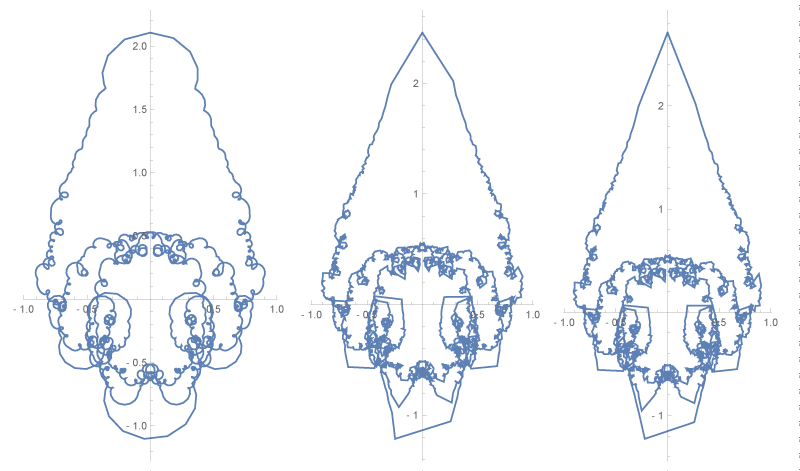Annals of Mathematics and Physics
Lissajous curves with a finite sum of prime number frequencies
Imre Ferenc Barna1* and László Mátyás2
2Department of Bioengineering, Faculty of Economics, Socio-Human Sciences and Engineering, Sapientia Hungarian University of Transylvania Libertătii sq. 1, 530104 Miercurea Ciuc, Romania
ORCiD: http://orcid.org/0000-0001-6206-3910
Cite this as
Barna IF, Mátyás L (2022) Lissajous curves with a finite sum of prime number frequencies. Ann Math Phys 5(2): 137-139. DOI: 10.17352/amp.000054Copyright Licence
© 2022 Barna IF, et al. This is an open-access article distributed under the terms of the Creative Commons Attribution License, which permits unrestricted use, distribution, and reproduction in any medium, provided the original author and source are credited.The Ulam spiral inspired us to calculate and present Lissajous curves where the orthogonally added functions are a finite sum of sinus and cosines functions with consecutive prime number frequencies.
We may say that prime numbers fascinates mankind for more than two thousand years. The scientific literature of number theory - which in great part deals with prime - is enormous and fills libraries. Number theory is not our field of interest at all, so it is not our duty to give any kind of overview of the field, therefore we just mention two works about primes [1,2]. (Our scientific interest is laser-matter interaction [3] and self-similar solutions of non-linear partial differential equations of flow systems [4].) We just would like to show a tiny idea about primes which might be interesting to the experts. Two starting points that gave as the idea. The first is the Ulam spiral which was found by Stanislaw Ulam in 1967 [5]. The left figure in Figure 1 shows how the spiral is defined, the middle figure shows how the prime numbers are distributed among the first 400 natural numbers, and the last right figure presents the prime distribution on a much larger scale. The primes are represented with dark dots, spots, and with short lines. It is evident, that there is a non-trivial correlation of primes even on large scales in this representation.
Our second starting point is the definition of Lissajous (or Bowditch) curves [6] which are a well-known object for physicists. The parametric formula of the curve reads
where 'a', and 'b' are the relative frequencies and is the phase between the two oscillations. Figure 2 presents three classical Lissajous curves with various relative frequencies and phases between the two trigonometric functions. The length of the corresponding parametric curve is defined as
where prime means derivation with respect to the parameter t. With this formula, it is trivial to get back the circumference of a unit circle. It is also clear that the length of various Lissajous curves is proportional to . Differential geometrical analysis helps to derive and study additional parameters of the curve.
Let's try to image the distribution of primes somehow with the help of the Lissajous curves.
We applied the next parametric formula for the curve
where s are the first N prime numbers. Figure 3 shows the Lissajous curves for and 5000 where the last primes are 541,7919 and 104729. To achieve a finite surface for the Lissajous curve we divide the sum of sinus and cosines functions with the corresponding prime number. Note, the slight left-right symmetry breaking of the curves. These are our starting points, of course, the applied curves can be changed in numerous ways.
In the second case, Figure 4 presents two curves where only the second neighbor primes are considered to the 'x' and 'y' coordinates such as 2,5,11 and 3,7,13. Note, with the much quicker convergence, it is not possible to see the differences between the two figures with naked eyes. We tried to modify Eq. (3) with additional logarithmic, square root, or power law functions of the argument of the sinus and cosines function to create a much more internal structure of the curves at a larger number of primes. Unfortunately in vain. This is the present endpoint of our idea and analysis. (The presented calculations and figures were evaluated with Maple 12.) It can happen that our toy model might give an idea for such kind of further investigations.
- Maier H, Schleich WP (2009) Prime Numbers 101, Wiley Interscience.
- Estermann T (1952) Introduction to Modern Prime Number Theory, Cambridge the University Press.
- Barna IF, Pocsai MA, Varró S (2018) Eur. Phys. J. Appl. Phys. 84, 20101.
- Barna IF, Pocsai MA, Mátyás L (2020) Fluid. Dyn. Res. 52, 015515.
- Stein M, Ulam SM (1967) "An Observation on the Distribution of Primes." American Mathematical Monthly 74, 43.
- Lawrence D (1972) A Cataloge of Special Plane Curves, (Page 178.) Dover Publication.
Article Alerts
Subscribe to our articles alerts and stay tuned.
 This work is licensed under a Creative Commons Attribution 4.0 International License.
This work is licensed under a Creative Commons Attribution 4.0 International License.
 Help ?
Help ?

PTZ: We're glad you're here. Please click "create a new query" if you are a new visitor to our website and need further information from us.
If you are already a member of our network and need to keep track of any developments regarding a question you have already submitted, click "take me to my Query."






 Save to Mendeley
Save to Mendeley